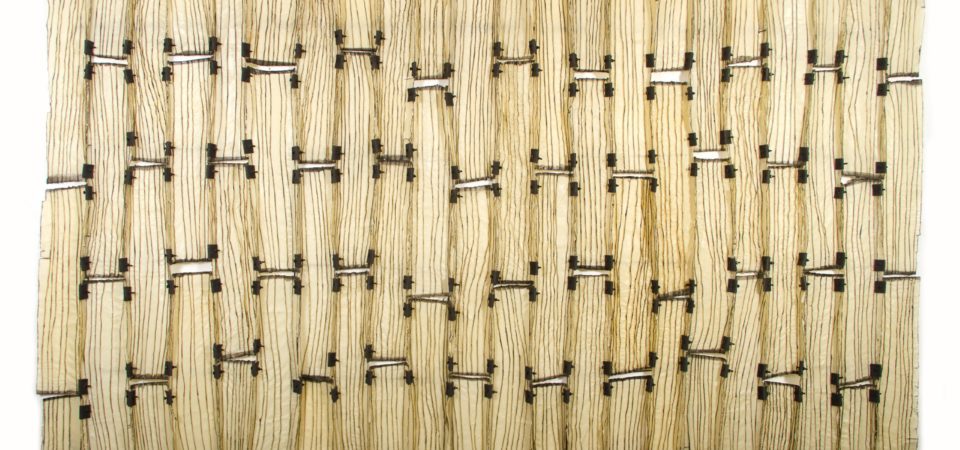Brenda Mallory “Reformed order” (detail) Photo Brenda Mallory © 2021
This is the first of four interviews in the series
Series Introduction by Cameran Bahnsen
I am part Assiniboine, a Native American tribe based in Montana under the Fort Peck Reservation. As an Indigenous student and aspiring leader in environmentalism, I hope to aid in the effort of making Indigenous voices heard while taking part in the fight against the climate crisis. It is unquestionable that our culture and history place value on environmental wisdom, responsibility, and reciprocity. Throughout my life, connecting to other Indigenous peoples through powwows, academia, community-based groups, and traditional ceremonies has made me feel honored to be a descendant of the original land and water keepers.
According to the Center for International Forestry Research, “Indigenous Peoples manage or have tenure rights over at least ~38 million km2 in 87 countries or politically distinct areas on all inhabited continents. This represents over a quarter of the world’s land surface, and intersects about 40% of all terrestrial protected areas and ecologically intact landscapes (for example, boreal and tropical primary forests, savannas and marshes)”. Today, there is still a large amount of land that tribal members have management over. Protecting these landowners and their voices means protecting the land itself, and I believe civil society can undoubtedly learn from Indigenous Peoples and our relationship with the earth.
Before the American Indian Religious Freedom Act of 1978 was passed, my own grandfather experienced an era of the suppression of Indigenous voices as a young adult. Even though these voices have become lost over time, I am hopeful that the world is slowly beginning to realize that Indigenous perspectives provide invaluable information on how to positively navigate relationships with the earth. Greta Thunberg addressed this when she spoke out against the Keystone XL Pipeline in 2019: “Indigenous peoples have been leading this fight for centuries […] They have taken care of the planet and they have lived in balance with nature and we need to make sure that their voices are being heard. We need to listen to them because they have knowledge that is valuable right now (rapidcityjournal.com).” Even the Intergovernmental Panel on Climate Change (IPCC) has “highlighted the key role traditional landholders” play and the importance of governments recognizing “the land rights of those groups over the territory they inhabit and manage.” Historically, suppression and forced assimilation have tried, and partially succeeded in reducing the presence of Indigenous people, which may be why we are not traditionally seen as key political actors today. In regards to climate activism, this perspective needs to change.
The following interview pieces highlight the voices and experiences of four Indigenous people of various ages, occupations, and backgrounds. Integrated within each interview is the work of four Indigenous artists, who capture the traditions of our people and Mother Earth through their artistic vision and abilities. In this four-part series, one interviewee and one artist will be featured with each publication. I hope to share the stories and traditions of my people and illustrate how Indigenous people navigate the climate crisis. I believe our unique mindset and interconnectedness with nature has important information and solutions to our current climate issues. By exploring the connection between traditional Indigenous environmental knowledge and the global environmental solutions we are currently seeking, I hope to place value on the importance of diverse voices around the world.
Disclaimer: I do not support the tokenization and extraction of Indigenous knowledges and people. Upholding ways that respect and honor Indigenous knowledges and people is of the utmost importance. Every Indigenous interviewee and artist has given me their consent to share their words for this piece.
Spoken Interview with Shanny Spang Gion
Cameran Bahnsen: What do you believe are the defining aspects of how Indigenous people view the Earth?
Shanny Spang Gion: I would venture to say that there are a few defining aspects of how Indigenous people view the Earth and our greater universe. One is that our belief systems, knowledge, cosmologies and values are cyclic. We tend not to think in a one-directional manner, such as a linear sense of time as Western culture does. I also think relationship and relational accountability are fundamental to how we view the Earth and our place in it. We have to take great care to tend to and foster our relationships with both human and more-than-human relatives. I also think our knowledge and view and experience on this Earth are very diverse, making our knowledge quite diverse across individuals, families, and nations.
CB: What traditions or stories have shaped how you view and treat the Earth?
SSG: There are a few stories I can think of. One is within the context of my tribe’s colonial experience. We hold a shared experience with other tribes in that we were forced on to lands not familiar to us in present-day Oklahoma. It was at great risk and sacrifice, but part of our people made the choice to leave and attempted to return to our homelands in present-day Montana. It is their sacrifice, the sacrifices of our ancestors, that I have the honor to call this place home, that I think of every day and it has shaped how I walk in this Earth space. I’m filled with gratitude.
Brenda Mallory
Slipping Into Order: A Glitch in the Phylum
Organic sculptures co-mingle with found objects, both natural and manmade, blurring and confusing the distinction between technology and nature in a theatrical construction that invites sorting, counting, naming, and viewing through a microscope. Strewn botanical drawings, schematics, and buckets of specimens create a classifier’s workshop.
CB: What do you think Western cultures can learn from Indigenous people when considering global environmentalism?
SSG: I think one of the most important lessons to be learned is that all things are alive, and have a spirit and energy within them. To respect each part of this Earth as having a spirit and to honor our relationship with these relatives can serve to decentralize human-use based conservation philosophy and practices.
CB: How can Indigenous ways of understanding the environment allow us (humans) to change our relationship with the Earth?
SSG: Relationships are so crucial to how we navigate this physical and nonphysical space. That relational accountability is important. You can say you have a relationship with someone, but maybe you’re not tending to that relationship, you don’t foster it, you don’t make time. In human to human relationships, for instance, you can say you know someone, but you don’t really talk to them that often, so it is not really a deep and meaningful relationship where you take the time to say “Hey how are you? How’s your family?” or go see them, or stay in touch- that’s one example of a relationship. But I would say, the biggest thing we can do is de-center ourselves and not think of ourselves as separate from our environment and natural systems. Some tribes even think that humans, if there were a hierarchy, would be kind of on the lower end of that hierarchy. I think just that one practice of saying, “I’m only a human being, I’m only a part of the Earth that we all share” and trying to look at the relationship you have with different parts of our Earth is so important. For instance, sometimes when I go out and go for walks I talk to the plants about how my day was and touch them because maybe I had a bad day. They really help heal me, and I come back feeling better, feeling more centered, and able to move on that day and take care of my family. So my relationship with our plant relatives is really important to me. It takes a sense of openness and humility to look at the Earth in a spiritual way, and not just in a western, STEM, science way, and knowing that your relationships with all the different parts of our Earth are spiritual too. When you are standing directly next to a water body, it’s not just physical, it takes a lot more to understand and respect the different spirits that can reside in different areas. For me, I like to give examples and share things through stories. I want to share a quick story that shows how our way of understanding can change our relationship with the Earth. It really just has to do with water. In Northern Cheyenne world-view, we see springs as a site that is very sacred and spiritual, and it is considered to be a spiritual corridor where spirits gather and can reside. For us, that means some of these spirits, particularly, called “mynth” in Cheyenne (serpent spirit), reside there. They may not always show themselves, or one may come and not the others, but there is one spirit that I was always told that only seeks to do you harm. So to avoid that spirit, we have protocols around springs- avoid the spring sites around certain times of the day and during storm events, and to not visit a spring by yourself. It is a practice we uphold to respect those spirits and give them their space for when they are more likely to appear, and also to protect ourselves from harm. Because it’s an active spiritual corridor for us and we want to physically keep it clean, we also take care of the site and not allow it to be damaged in any way. That’s one way, I think, we are able to decenter ourselves, with our relationship to water, springs, and the spirits that reside there. We don’t say “this spring is just here for my use and for me to get drinking water” or whatever it may be, we honor and uphold first that it is a very spiritual place.
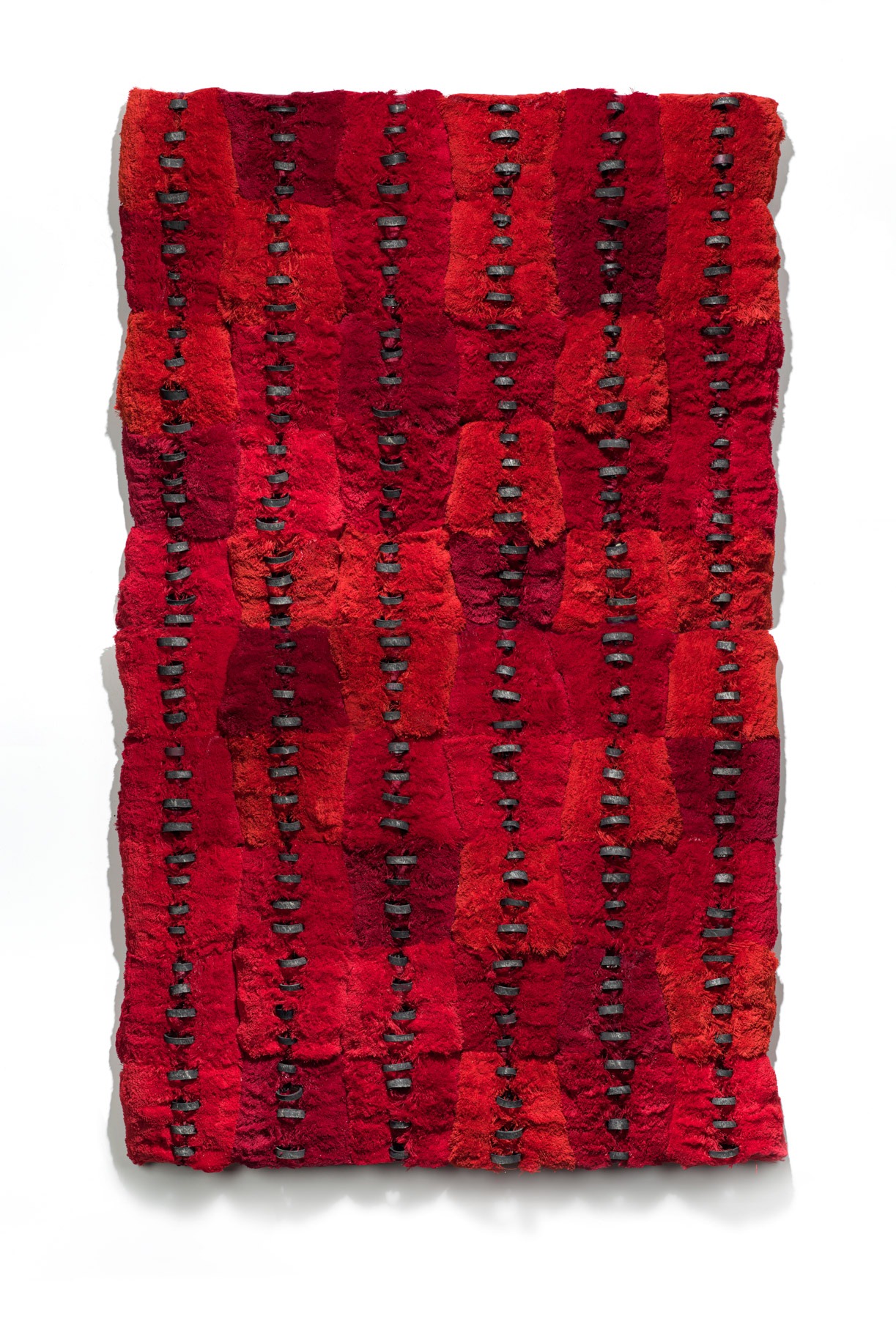
Brenda Mallory
Proximate Parcels
Proximate Parcels is comprised of spools of industrial sewing thread that have been sliced apart to expose the individual strands. The act of cutting something apart down to its core, effectively destroying its original function, but then reforming it into a beautiful lush object reflects my interest in how things that are broken or disrupted are often still viable and lively. The varying shades of red reference the complicated issues around blood quantum that even to this day inform certain Native American tribal enrolments. The title Proximate Parcels refers to allotment policies that destroyed the communal landholdings of many Oklahoma tribes, including that of my tribe, Cherokee Nation. Sometimes families were lucky enough to have their parcels near each other, other times the allotments were far distances, contributing to isolation.
CB: Is it important that the global citizenry activate Indigenous ways of knowing?
SSG: It is important for our own ways of knowing to be shared, as long as it is done in the appropriate way. There have been instances when there is a ceremony that someone might want to learn about and they get into a community […] and they take that knowledge and they misuse it. They go out and try to start holding their own ceremony for profit, and people will sometimes abuse that knowledge. That goes back to the idea of relationships.
In terms of traditional knowledge, and how it might intertwine with different initiatives, I think of all of the awesome work that’s out there by Indigenous scholars and scientists that finds that balance between doing research in a responsible and appropriate way, while also upholding their own knowledge systems from their own tribe- as long as those ways of knowing are honored and respected, and there are guidelines set up for their use in any specific manner. So, in terms of climate change even, a resource I came across a few years ago, in light of climate change, is called “Guidelines for Considering Traditional Knowledges in Climate Change Initiatives” by several different Native scholars (linked here: https://climatetkw.wordpress.com). This kind of goes through and touches on goals and guidelines that could be applied anywhere, even outside of a climate change context. I think there are ways, especially what Indigenous scholars and people are thinking, that provide protections for our knowledge systems and ways of knowing. I guess the long and short is, I think it’s important, but I also think it’s even more important for the broader community of humans to do it in the right way and make sure they’re doing things in a good way with the tribal individual, community, and nation.
CB: Is it possible/appropriate to bridge the gap between traditional Indigenous environmental approaches and scientific knowledge to contribute to a more sustainable future?
SSG: Absolutely, but I would qualify that by saying it is very dependent upon and specific to each tribal/Indigenous nation, and relationships formed/maintained/fostered amongst tribal nations, tribal members, universities, etc. is paramount. There is an ever-growing number of Indigenous and non-Indigenous academics who are already navigating and finding appropriate pathways within academia do just that. I am honored to count myself among those who are seeking to find ways to balance knowledges and how that informs the ways we choose to think and form projects/research, practice science and most importantly, finding a path to walk that honors and upholds Indigenous knowledges of our nations and ancestors as an equally relevant way of viewing and being in relation to our non-human/more-than-human relatives. In my own graduate research experience, I aimed to find ways in which Traditional Knowledge and Western Science can, together, inform how water is valued, viewed and managed at a local scale, on the Northern Cheyenne Reservation (present-day Montana). My research utilized both Western Science and Indigenous Research methods to explore how these two ways knowing can co-exist. I chose a watershed that drains a good part of my reservation at Northern Cheyenne, Rosebud Creek, and focused on identifying groundwater-surface water interaction of water resources in this watershed while simultaneously gathering Traditional Knowledge surrounding water use, tribal values, and knowledges from the Northern Cheyenne worldview. Stable isotopes of oxygen and hydrogen were used to identify source waters of Rosebud Creek. Additionally, I recognized that traditional knowledge and ways of knowing only come from living in, relating to, and experiencing this world. Thus, I chose to uphold my tribe’s way of communicating knowledge through utilizing Indigenous Research Methods to converse with knowledge holders about water. The research and findings were intended for consideration by my tribal community and tribal government towards changing and informing water resources policy and management for the Northern Cheyenne Tribe.
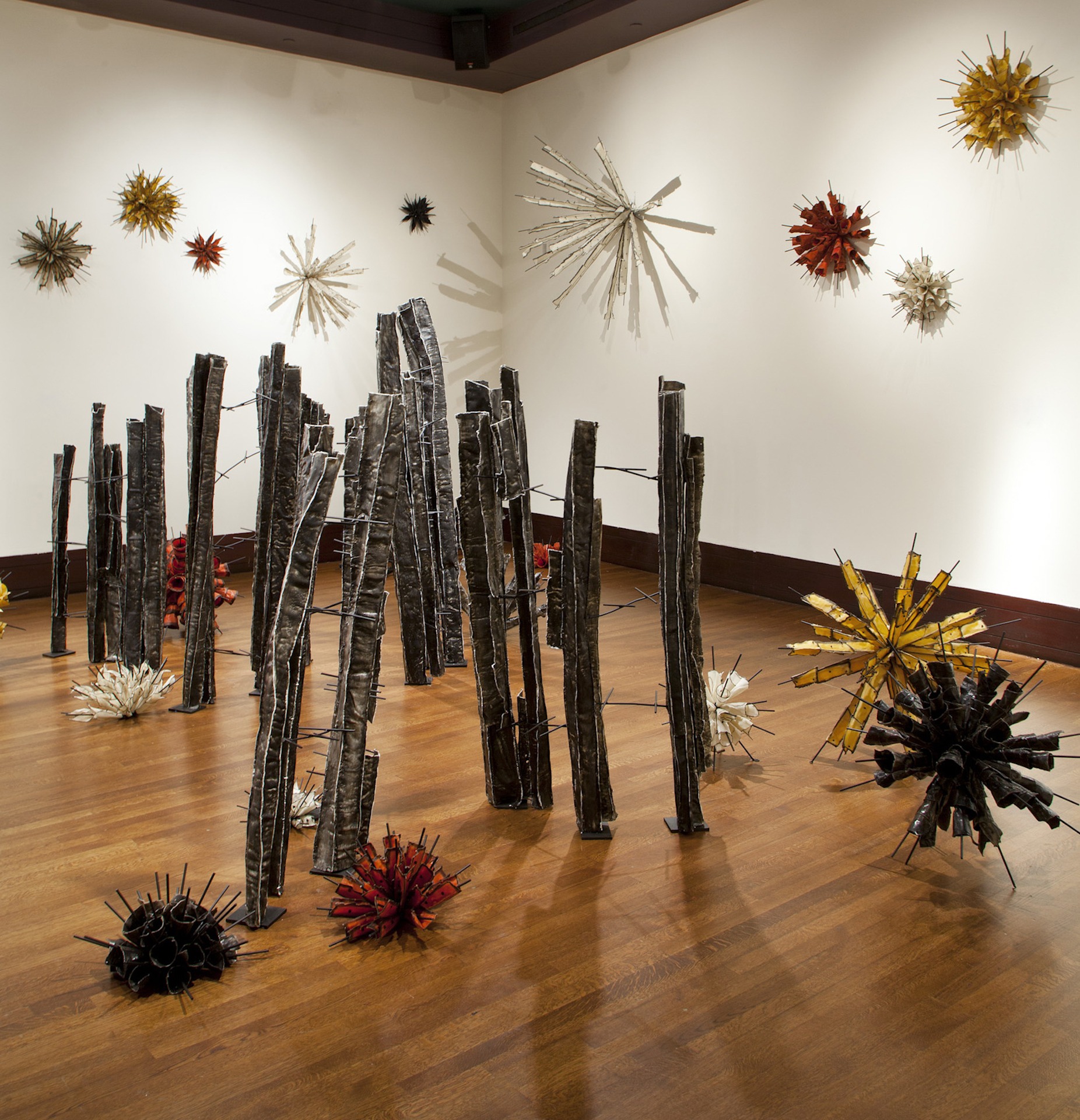
Brenda Mallory
Recurring Chapters in the Book of Inevitable Outcomes
Recurring Chapters in the Book of Inevitable Outcomes was inspired by Cherokee history. Like many peoples that have suffered colonization and repression, the Cherokee culture has endured through hardships and travails to remain a vital presence. Lively spore-like clusters dance around somber leaning forms that resemble charred timbers, evoking both loss and hope to represent a resilient people.
CB: What are some community approaches to addressing the fact that Indigenous communities are often disproportionately affected by climate change?
SSG: For this question, I think about not only if you’re living close to water and how changes in our climate can affect how/where you live near water, but also I think about our winter months, even our late summer months, where we may not have enough water for our own living, let alone trying to use it for agriculture or other purposes, the biggest thing I think we can do as a community, which has probably been seen across many different platforms and organizations, is to really look at how we can make ourselves and how we live more sustainable. That can happen through embracing renewable energy sources, and also in our day-to-day as individuals and families, choosing how we want to live. In Cheyenne history, we were at one time in present-day North Dakota area, and we were farmers living in Earth lodges before we came onto the plains. I would even say we should revisit how we choose to live in our homes. If that means we try to live in Earth lodges to help make ourselves more sustainable and have it be more of a natural heat/cooling source of the Earth, or if we do still use modern ways of making homes but making it way more energy-efficient. That’s been a real struggle in my area, as I’m sure it is in other communities.
CB: What do you see as the largest barriers to enacting the change we need to see in order to live more sustainable lives and protect the Earth’s resources?
SSG: One of the things, more and more, that I see is the United States accepted practices of living relies heavily on plastics. We are all a part of that, it is not any one person, community, or sector of our society. We are all very heavily dependent on plastic, from our shoes, to plastic bags, to food packaging. And I think that is a large barrier. Our society is set up to have that convenience, and I do it too. I like having vegetables that are out of season, and they usually come in plastic. I think the culture of convenience in the U.S is a large barrier. It’s so big, sometimes I get overwhelmed by it, and try to improve my lifestyle choices day-to-day.
On the food side, that sovereignty is being able to provide food for ourselves. On the broader scale, I like the culture that’s shifting on trying to find more local food. Buying local food as much as we can and really thinking about our food sources. That’s the kind of change we need to see, examining our own cultures we’ve adopted in the broader consumerist sense.
In regards to the Indigenous mindset of relationships we’ve discussed… In my home community, we have adopted the mindset of consumer culture, I think because of part of our history and the historical trauma we’ve experienced, there can be a community level mentality that you have to have certain things that express the level of success or amount of care you can give to your children. Sometimes that is expressed through consumer goods. There are families that will buy top-of-the-line everything because it’s an expression of how much they care for that child. It’s kind of an adaptation, where traditionally it might have been making them a dress or traditional doll, where before we were colonized. If we can get back to those values of care but practice it differently, then I think we can enact that change to live more sustainable lives.
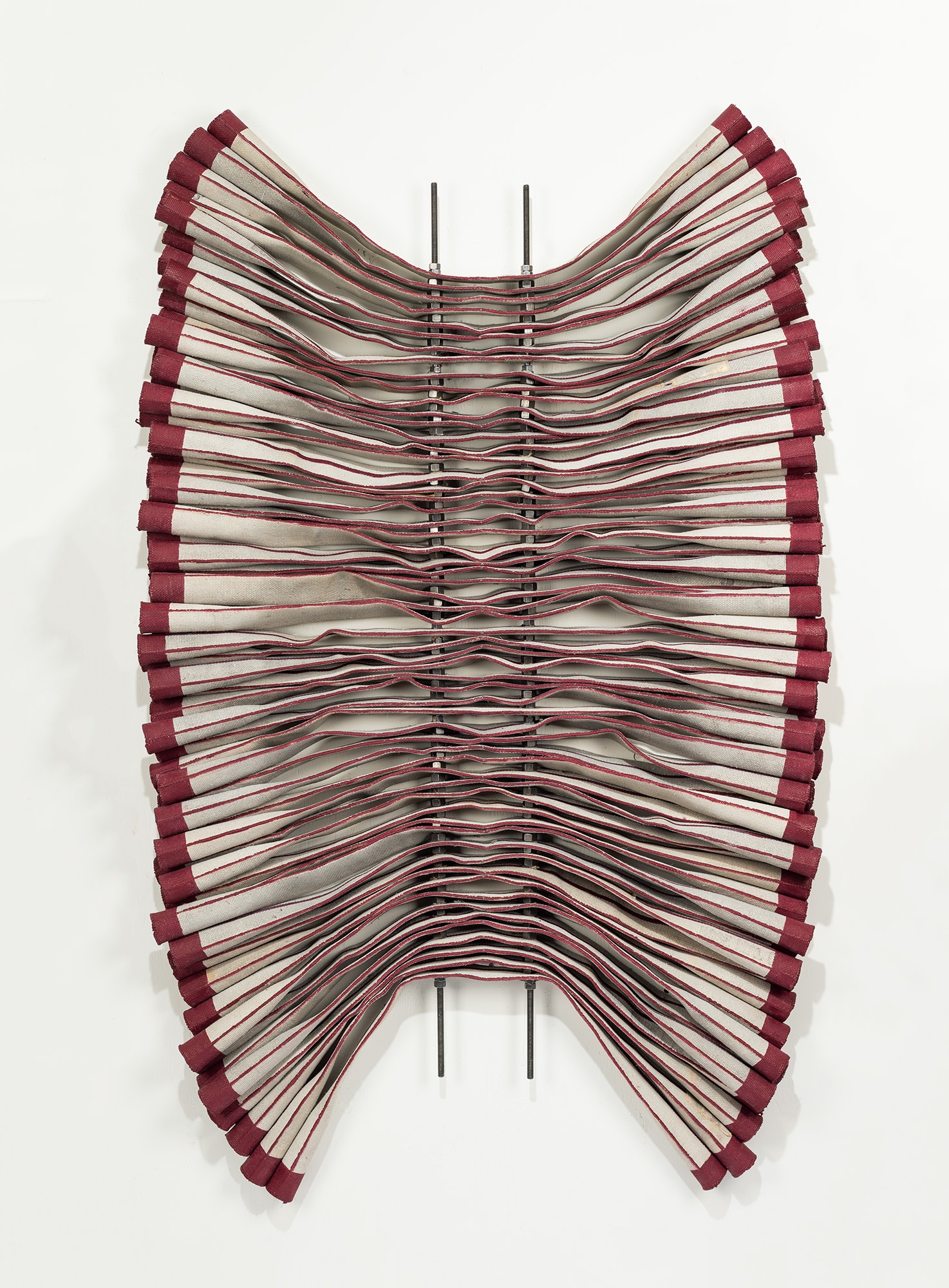
Brenda Mallory
Firehose Experiment
Firehose Experiment #8 (Bioform) is made from linen firehoses I found at the dump during my GLEAN Residence in Portland. It is an artist residency where five artists get to spend five months with access to the Waste Transfer Station (aka The Dump). I loved that residency and it made me happy to access all the great treasures, but sad to see the way our culture throws away resources. I felt like a whole sociological study could be done there. American consumers have access to cheap goods because of the cheap labor of disadvantaged workers in other countries. Over consumption, single use plastics, and built-in obsolescence – it’s a broken system that’s bad for people and the planet.
CB: What support do you and/or your community need to better address some of the challenges and problems we’ve discussed today?
SSG: I can see multiple ways and levels in which we as a tribe can effectively engage in issues such as water protection and climate change that uphold our value systems. Support may be in the form of community education around many things, including how to care for ourselves in the midst of our colonial experiences and historical traumas. I strongly believe in learning together, with each other, so community education may also be a great opportunity to learn about the innovative and forward-thinking approaches to caring for the Earth that other countries and Indigenous nations have employed. One such example that I only briefly got to examine in graduate school is that of progressive legal policy for water governance. In short, there are nations that are providing legal personhood to river systems as a form of protection that recognizes the river’s right to exist as its own person without being harmed. The legal personhood granted to the Whanganui River in New Zealand is an especially powerful example. To think beyond the environmental governance frameworks currently in place in the United States is a huge action that we can all do right now. Then, we can begin our own journey of implementing ways of protection of our more-than-human relatives and the Earth as a whole.
I want to thank both Shanny and Brenda for their kindness, strength, and vulnerability. I met Shanny through my uncle, and I am deeply inspired by her work as she navigates combining western science and traditional Indigenous knowledges. Her caring and positive spirit instantly made me feel like family. I connected with Brenda online via Instagram, and I was incredibly touched by her creativity and passion. Her humble attitude and welcoming arms are qualities that I deeply admire about her. I am so honored to have worked with both of these amazing women.
Cameran Bahnsen
Disclaimer: The words and art of the featured interviewee and artist are independent of each other and only reflect their own viewpoints and opinions. They are not reflected through each other in any way.
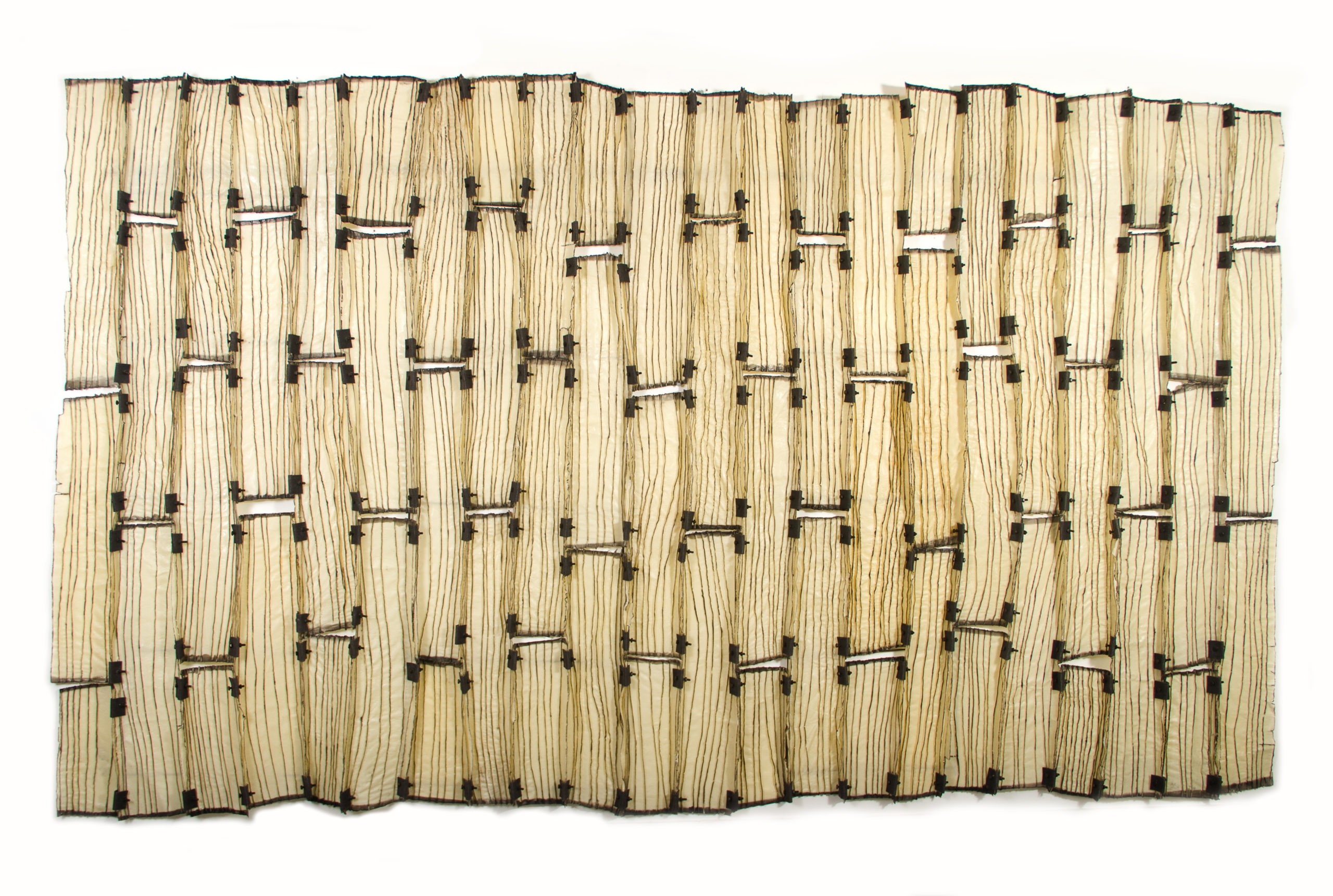
Brenda Mallory
Reformed Order
Reformed Order is a reclaimed material of sorts – reclaimed from myself! In 2011, I did a large site-specific installation at Portland International Airport entitled Mechanics of Hither & Yon, about the way air travel affects the would so quickly (whether germs, ideas, cultural shifts). The installation included some 25 feet tall vertical wall pieces. At the end of the installation, rather than throw them away, I sliced them up and turned them into Reformed Order.
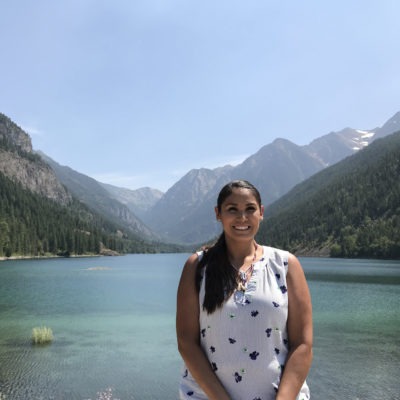 Shanny Spang-Gion
Shanny Spang-Gion
Shanara “Shanny” Spang-Gion is Northern Cheyenne and Crow, with German heritage, and is enrolled in the Northern Cheyenne tribe located in present-day Montana. She is the Executive Director of Southeast Montana Area Revitalization Team, a non-profit organization in Fallon County, and the Secretary of the Tongue River Water Users Association in Montana. She earned her Masters degree in Interdisciplinary Studies – Hydrogeology and Technical Communication, from Montana Tech of the University of Montana, where her research utilized both Western Science and Indigenous Research methods to explore how these two ways of knowing can co-exist and inform how water is valued, viewed and managed at a local scale, on the Northern Cheyenne Reservation (present-day Montana). She earned her bachelor’s degree in Environmental Science at Montana State University and she currently also currently serves as a consultant at Montana Tech, where she assists in sustaining and institutionalizing the Indigenous Mentoring Program. She served on the Bureau of Land Management Eastern Montana Resource Advisory Council from 2008-2011 and the MT Department of Natural Resources and Conservation Yellowstone River Basin Advisory Council from 2013-2014. Under her direction, the Cheyenne Wetlands Program Plan (2014-2019), Northern Cheyenne Aquatic Lands Protection Ordinance (2017), and Northern Cheyenne Culturally Significant Riparian and Wetlands Plants List (2015) were completed with a majority of authorship as a collaborative effort of multiple stakeholders on behalf of the Northern Cheyenne Tribe’s Department of Environmental Protection and Natural Resources. She is a mother to two Northern Cheyenne/Crow/German children.
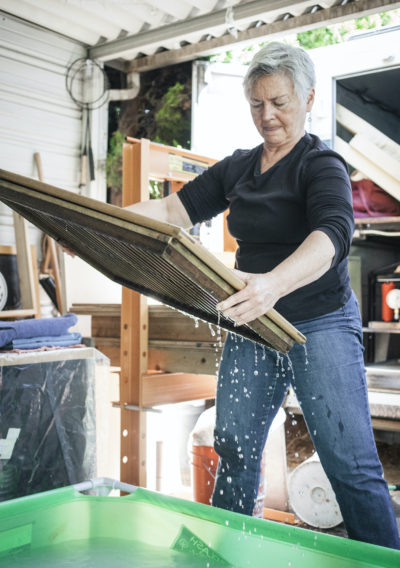 Brenda Mallory
Brenda Mallory
Brenda Mallory’s work ranges from individual wall-hangings and sculptures to large-scale installations. She works with mixed media and organic materials, creating multiple forms, often joined with crude hardware or mechanical devices in ways that imply tenuous connections and aberrations. Texture and repeated rhythmic forms are instrumental to Mallory’s abstract compositions that deal with concepts of disruptions and repairs. She is interested in ideas of interference and disruption of long-established systems in nature and human cultures.
A resident of Portland, Oregon for many years, Mallory grew up in Oklahoma and is a citizen of the Cherokee Nation. She received a BA in Linguistics & English from UCLA and a BFA from Pacific Northwest College of Art. Mallory has received multiple grants including from the Oregon Arts Commission, Ford Family Foundation, Regional Arts & Culture Council. She has received the Eiteljorg Museum Contemporary Native Art Fellowship and the Native Arts and Culture Foundation Fellowship in Visual Arts. Residencies include Anderson Ranch, GLEAN, Crow’s Shadow Institute of the Arts, C3: Papermaking Residency, Jordan Schnitzer Printmaking Residency at Sitka Center, Signal Fire, Bullseye Glass, and Ucross where she received the Fellowship for Native American Visual Artists.
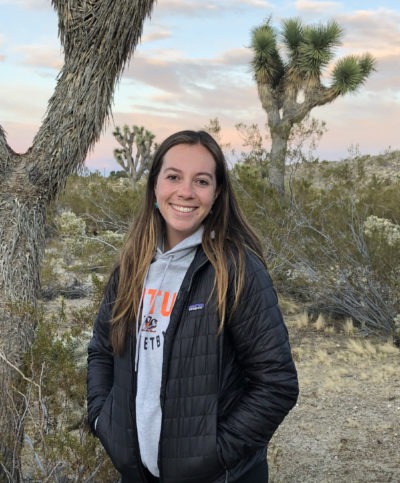 Cameran Bahnsen
Cameran Bahnsen
Cameran Bahnsen was raised in Ventura County, located in Southern CA. She is part Assiniboine (Fort Peck Reservation, Montana) and currently attends the University of California, Santa Barbara. She is pursuing a B.S in Environmental Studies with a minor in American Indian and Indigenous Studies. At a young age, she grew up beach camping with her family, which inspired an early love for the outdoors. Her love of nature, coupled with her cultural connection, continue to drive her aspirations of working within resource management, environmental education, interpretation, tribal relations, and conservation. She enjoys hiking, camping, backpacking, cooking, listening to music, and spending time with friends and family.
The MAHB Blog is a venture of the Millennium Alliance for Humanity and the Biosphere. Questions should be directed to joan@mahbonline.org
This article is also part of the MAHB Arts Community‘s “More About the Arts and the Anthropocene”. The MAHB recognizes the value and importance of learning and listening from Indigenous people. In an effort to honor Indigenous voices, if you are an artist that identifies as Indigenous and you are interested in sharing your thoughts and artwork, as it relates to the disrupted but defining period of time we live in, please contact michele@mahbonline.org

